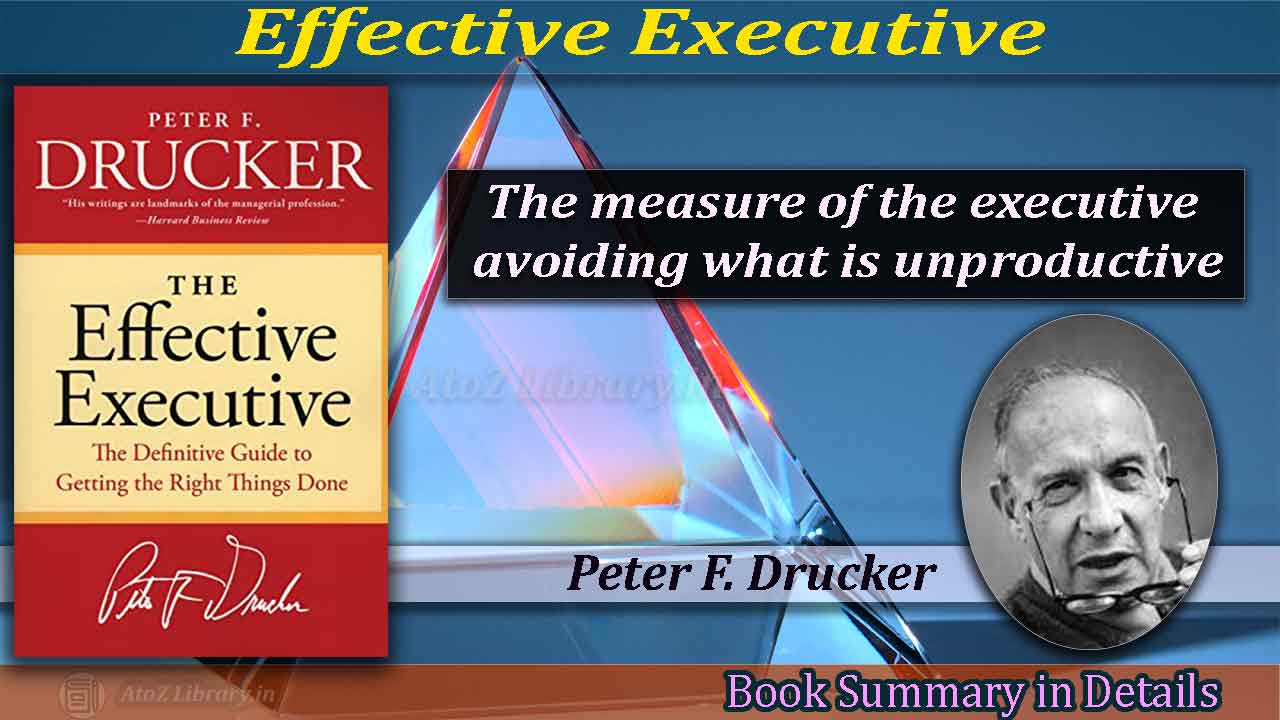Introduction
Through The Effective Executive Summary You Will Get To Know About The Full Book Overview. The Effective Executive is a ground-breaking book by Peter F. Drucker, one of the world’s most influential management thinkers. In this seminal work, Drucker provides valuable insights into the qualities and characteristics that define effective executives, and offers practical advice on how to become one. Based on decades of experience and extensive research.
This book provides a roadmap for success that is still relevant today, more than 50 years after its original publication. Whether you are an aspiring executive or a seasoned professional, this book is a must-read for anyone looking to achieve greater effectiveness and success in their role. In The Effective Executive summary, we will examine the key takeaways from Drucker’s classic work and explore how they can help you become an effective executive.
About The Author Of “The effective executive”
Peter F. Drucker was a renowned management consultant, educator, and author. He was born in Austria in 1909 and later immigrated to the United States, where he established himself as one of the foremost experts in the field of management. Drucker wrote over 30 books on various aspects of management, including “The Effective Executive,” which was first published in 1966. In this seminal work, Drucker identifies the key traits and habits of effective executives and offers practical advice on how to become one. Throughout his career, Drucker was known for his innovative ideas and insights into the world of business and management, and he continues to be regarded as one of the most influential management thinkers of the 20th century.
What We Can Learn From “The effective executive Summary”
In this book, readers can learn the following key takeaways:
- The Importance of Focus: Effective executives focus their time and energy on their most important priorities and delegate the rest.
- The Power of Habits: Successful executives develop habits and routines that allow them to be productive and make the most of their time.
- The Art of Decision Making: Effective executives make decisions quickly and confidently, using clear criteria and avoiding analysis paralysis.
- The Value of Self-Reflection: Successful executives reflect on their own performance regularly, seeking feedback from others and continuously improving.
- The Necessity of Action: Effective executives are not afraid to take action and make things happen, using their initiative and creativity to overcome obstacles.
These are just a few of the many valuable lessons that can be learned from “The Effective Executive.” Whether you are an aspiring executive or a seasoned professional, this book offers a wealth of practical advice and insights that can help you become more effective in your role and achieve greater success.
Effectiveness Can Be Learned
From “The effective executive Summary”
This Chapter explores the qualities and characteristics of effective executives. In the chapter “Effectiveness Can Be Learned,” Drucker argues that anyone can become an effective executive, regardless of their background or innate abilities.
Drucker starts the chapter by highlighting that many people believe that effectiveness is a product of natural talent or personality, and that it cannot be learned. However, Drucker disputes this idea and asserts that anyone can become effective through a combination of learning and practice.
He then goes on to explain that the first step to becoming an effective executive is to understand the nature of effectiveness. Drucker identifies two key components of effectiveness: knowing what one’s strengths and weaknesses are, and knowing how to use one’s time effectively. He emphasizes that an effective executive must be able to focus their time and energy on their most important priorities, and delegate the rest.
Drucker also stresses the importance of developing good habits and routines, as these can help executives to be more productive and make the most of their time. He notes that habits are not just automatic actions, but conscious decisions that can be deliberately cultivated and strengthened over time.
In addition, Drucker emphasizes the importance of self-reflection in the development of the effectiveness. He notes that effective executives regularly reflect on their own performance, seeking feedback from others and continuously improving.
Finally, Drucker stresses that effectiveness is not just about having the right knowledge and skills, but also about taking action and making things happen. Effective executives are not afraid to take initiative and make decisions, using their creativity and resourcefulness to overcome obstacles and achieve their goals.
Know Thy Time from “The effective executive Summary”
“Know Thy Time” is a chapter in the book “The Effective Executive” that focuses on the importance of using time effectively in order to achieve success as an executive.
Drucker starts the chapter by highlighting the scarcity of time and the fact that time is a limited resource that cannot be saved, extended, or recovered. He argues that effective executives understand the value of time and are able to prioritize their most important tasks and responsibilities in order to make the most of their limited time.
To explain the concept of “time management,” Drucker defines as the deliberate and systematic allocation of time to the various activities and tasks that are essential to the executive’s role. He stresses the importance of identifying the most critical tasks and focusing on them first, while delegating or outsourcing less important tasks to others.
Drucker also highlights the importance of effective decision-making in the management of time. He notes that effective executives are able to make decisions quickly and confidently, using clear criteria and avoiding analysis paralysis. He stresses the need for executives to be proactive, taking action and making things happen in order to achieve their goals.
In addition, Drucker emphasizes the importance of avoiding distractions and interruptions, which can consume valuable time and reduce productivity. He notes that effective executives are able to maintain focus and stay on track, even when faced with challenging or unexpected situations.
Finally, Drucker concludes the chapter by emphasizing that time management is not just a technique or a set of tools, but a mindset and a habit that must be cultivated and strengthened over time. He notes that effective executives are able to balance their work and personal lives, creating a healthy work-life integration that allows them to be productive and fulfilled both in and outside of work.
“Know Thy Time” is a powerful chapter that offers practical advice and insights on how to use time effectively and achieve greater success as an executive. By following Drucker’s advice and adopting a deliberate and systematic approach to time management, executives can prioritize their most important tasks, make better decisions, and avoid distractions, leading to increased productivity and success.
What Can I Contribute? from “The effective executive Summary”
The chapter “What Can I Contribute?” focuses on the importance of knowing one’s strengths and limitations, and using this knowledge to make the most meaningful contributions to one’s organization.
In this chapter, Drucker argues that effective executives have a clear understanding of what they are capable of contributing, and that this self-awareness is critical to success. He notes that executives must understand their strengths, weaknesses, opportunities, and limitations, and use this knowledge to focus their efforts and make the greatest impact.
Drucker goes on to explain that the first step in understanding one’s contribution is to identify one’s unique capabilities and skills. This involves assessing one’s strengths, weaknesses, interests, and experiences, and determining how these can be used to make a positive impact in the organization.
He also highlights the importance of setting clear goals and objectives, and using these as a guide to focus one’s efforts. Drucker notes that effective executives are able to balance their short-term and long-term goals, and continuously adjust their priorities as necessary.
In addition, Drucker emphasizes the importance of continuous learning and self-improvement. He notes that effective executives are always seeking new knowledge and skills, and are willing to invest in their own development. He argues that this pursuit of excellence not only leads to personal growth, but also contributes to the success of the organization.
Finally, Drucker concludes the chapter by noting that effective executives are able to understand the needs of their organization and align their contributions with these needs. He stresses the importance of collaboration and teamwork, and notes that effective executives are able to work effectively with others, leveraging the strengths of their team to achieve shared goals.
“What Can I Contribute?” is a thought-provoking chapter that offers valuable insights into the role of self-awareness and personal development in the success of an executive. By knowing their strengths and limitations, and continuously improving and growing, executives can make their greatest contributions to their organization and achieve greater success.
Making Strength Productive from “The effective executive Summary”
“Making Strength Productive” focuses on the importance of turning one’s strengths into a productive force. In this chapter, Drucker notes that effective executives have a clear understanding of their strengths, and are able to use these strengths to drive their success and the success of their organization. He argues that this requires a shift in focus from fixing weaknesses to leveraging strengths, and notes that this approach leads to greater success and fulfillment.
Drucker explains that making strength productive involves knowing one’s strengths and focusing on these areas, while also recognizing and accepting one’s limitations. He notes that this requires self-awareness and honesty, and that effective executives are able to acknowledge their weaknesses and seek help or support when necessary.
He also highlights the importance of identifying opportunities to use one’s strengths, and notes that effective executives are able to find creative ways to apply their skills and abilities to meet the needs of their organization. He stresses the importance of innovation and experimentation, and notes that effective executives are willing to take risks and try new approaches.
In addition, Drucker emphasizes the importance of continuous learning and improvement. He notes that effective executives are always seeking new knowledge and skills, and are willing to invest in their own development. He argues that this pursuit of excellence not only leads to personal growth, but also contributes to the success of the organization.
Finally, Drucker concludes the chapter by noting that effective executives are able to work effectively with others, leveraging the strengths of their team to achieve shared goals. He stresses the importance of collaboration and teamwork, and notes that effective executives are able to communicate effectively and build strong relationships with others.
“Making Strength Productive” offers valuable insights into the role of self-awareness and personal development in the success of an executive. By knowing their strengths and using these to drive their success, executives can achieve greater fulfillment and make a positive impact in their organization.
First Things First from “The effective executive Summary”
The Chapter “First Things First” focuses on the importance of effective time management and prioritization.
In this chapter, Drucker notes that effective executives are able to prioritize their tasks and responsibilities, and are able to focus on the most important and impactful activities. He argues that this requires a clear understanding of one’s goals and objectives, and a commitment to using time in a purposeful and productive way.
Drucker explains that effective time management involves setting clear goals and objectives, and using these as a guide to prioritize activities. He notes that this requires discipline and focus, and that effective executives are able to balance their short-term and long-term goals and adjust their priorities as necessary.
He also highlights the importance of being proactive, and notes that effective executives are able to identify and tackle important tasks before they become emergencies. He stresses the importance of avoiding distractions and interruptions, and notes that effective executives are able to stay focused on their priorities and avoid wasting time on unimportant activities.
In addition, Drucker emphasizes the importance of delegation and teamwork, and notes that effective executives are able to delegate tasks to others and build strong relationships with their team. He argues that this not only allows executives to focus on their highest priorities, but also contributes to the success and growth of the team.
Finally, Drucker concludes the chapter by noting that effective time management is a continuous process of self-reflection and improvement. He notes that effective executives are always seeking new ways to improve their productivity and efficiency, and are willing to make changes and adjustments as necessary.
“First Things First” is a thought-provoking chapter that offers valuable insights into the role of effective time management in the success of an executive. By prioritizing their tasks and using time in a purposeful and productive way, executives can achieve their goals and make a positive impact in their organization.
The Elements of Decision-making from “The effective executive Summary”
In this chapter, Drucker notes that effective decision-making is a critical component of effective executive leadership, and that it requires a systematic and thoughtful approach. He argues that decision-making is not a one-time event, but a continuous process of gathering information, evaluating options, and making informed choices.
Drucker explains that effective decision-making requires clarity of purpose and a clear understanding of one’s goals and objectives. He notes that this requires a focus on the long-term impact of decisions, and a willingness to take risks and make bold choices when necessary.
He also highlights the importance of considering multiple perspectives and gathering diverse inputs when making decisions. He notes that effective executives are able to seek out and consider multiple points of view, and are able to use this information to make informed choices.
In addition, Drucker emphasizes the importance of considering the consequences of each decision, and notes that effective executives are able to weigh the potential risks and benefits of each option. He argues that this requires a deep understanding of the context and consequences of each decision, and a willingness to consider the long-term impact of each choice.
Finally, Drucker concludes the chapter by noting that effective decision-making requires the ability to implement and execute decisions effectively. He notes that effective executives are able to act quickly and decisively, and are able to bring their decisions to life through effective implementation and execution.
“The Elements of Decision-making” is a valuable chapter that provides insights into the principles and techniques of effective decision-making. By following these principles, executives can make informed and impactful decisions that drive the success of their organization.
Effective Decisions from “The effective executive Summary”
This Chapter focuses on the importance of making effective decisions in the context of executive leadership.
In this chapter, Drucker notes that effective decision-making is a critical component of effective executive leadership, and that it requires a systematic and thoughtful approach. He argues that effective decisions are those that are based on sound judgment and accurate information, and that are aligned with the goals and objectives of the organization.
Drucker explains that effective decision-making requires a clear understanding of the context and the situation, and a focus on the long-term impact of decisions. He notes that this requires a willingness to take risks and make bold choices when necessary, and that effective executives are able to balance their short-term and long-term goals and priorities.
He also highlights the importance of considering multiple perspectives and gathering diverse inputs when making decisions. He notes that effective executives are able to seek out and consider multiple points of view, and are able to use this information to make informed choices.
In addition, Drucker emphasizes the importance of considering the consequences of each decision, and notes that effective executives are able to weigh the potential risks and benefits of each option. He argues that this requires a deep understanding of the context and consequences of each decision, and a willingness to consider the long-term impact of each choice.
Finally, Drucker concludes the chapter by noting that effective decision-making requires the ability to implement and execute decisions effectively. He notes that effective executives are able to act quickly and decisively, and are able to bring their decisions to life through effective implementation and execution.
“Effective Decisions” is a valuable chapter that provides insights into the importance of effective decision-making in the context of executive leadership. By following the principles outlined in this chapter, executives can make informed and impactful decisions that drive the success of their organization.
conclusion of “The effective executive Summary”
Throughout the book “The effective executive”, Drucker stresses the importance of taking a systematic and thoughtful approach to executive leadership, and highlights the importance of considering the long-term impact of decisions. He also emphasizes the importance of seeking out diverse perspectives, considering the consequences of decisions, and effectively implementing and executing decisions.
“The Effective Executive” is a valuable resource for executives, aspiring leaders, and anyone looking to improve their leadership skills. By following the principles and practices outlined in the book, readers can develop the skills and competencies needed to become effective and impactful leaders. Whether in the context of a large organization or a small startup, the principles and practices outlined in “The Effective Executive” are timeless and can be applied to achieve success in any leadership context.





